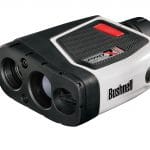

Rangefinder, as the name suggests, is a handy tool used by golfers to estimate the range i.e., the distance between themselves and their target. The game becomes pretty easy and fun when one knows how to use the rangefinder appropriately. Previously, optical rangefinders were used to help golfers in locating targets but innovations have been inevitable. Thus, GPS-based rangefinders and laser rangefinders are in the public eye these days. The aim and outcome of both of these are the same yet, they vary in their working principles. GPS-based rangefinders collect the required data from satellite feed and then help golfers with the relevant details. While, laser rangefinders have a laser beam that is directed to the target, and based on the time taken by the beam to hit the target, bounce back, and hit the sensor on the rangefinder, the range is located.
Whether you are a rookie in the field or an expert golfer there is always room for improvement. Moreover, this era calls for smart work instead of hard work so, one should make use of every stone to hit the target. Let’s begin with a few tips for how to use a golf rangefinder!
Buying the appropriate rangefinder:
Rangefinders come in different models and designs. One should look for the type that best suits his personality. Additionally, each type has its fors and againsts. For the GPS-based rangefinder, quality GPS signals and internet accessibility are the main prerequisites. Moreover, an updated map of the golf course needs to be available on the internet. So, if you prefer a golf course without internet (for focusing purpose or whatsoever reason) then you should probably go for a laser-based rangefinder. Although, laser-based rangefinders are less fast than GPS-based rangefinders yet they are more accurate.
User Manual:
One should always exploit the ability to read and comprehend. As soon as you have bought the most suitable rangefinder for yourself, you need to go through the user guide once. The guides usually illustrate the functioning of the device in a detailed manner along with some diagrammatic schemes that facilitate the users to operate the device. Before you begin with the rangefinder, you must be fully aware of all the functions of the buttons, knobs, lenses, etc.
Finding your target:
Practically, being the first step. Once you are on the golf course, you need to make use of the rangefinder on each step you are doubtful of. Using a rangefinder might not be as easy as it seems to be and demands a lot of practice. Before aiming at the target, you must adjust the settings of the device and you are ready to go. Now you have to choose the target e.g; a tree, a flagstick, etc. It is highly recommended to be in a parallel position about the target. Moreover, if you are using a laser-based rangefinder, try to select a target with some shiny surface such as a reflective surface at the top of the flagstick, so as more light to be reflected and better results to be achieved.
Aim the rangefinder at your target:
After sorting out your target be it a tree, a flagstick, a slope, etc. aim your device at your target. It is suggested to first aim the rangefinder at the ground where you are standing and aim at your chosen target that it could give a good estimate about the distance between you and your target. In case you are not getting a clear view, you can adjust the sight with the help of relevant knobs/buttons. It is noteworthy that some rangefinders are sensitive to the weather conditions such as temperature etc. So, these kinds of parameters must also be considered.
Activate the rangefinder:
Once you can see the desired target with the desired resolution you should activate the rangefinder. Most of the rangefinders vibrate as soon as they have locked the distance i.e., have estimated the range. The rangefinder will help you to estimate the yardage and have an idea about going for iron, wood, or a putter. Moreover, you will also have, by now, agues of how hardly or how lightly you should hit the ball. You can also approximate the number of shots it will take to reach the goal.
Keep your rangefinder steady:
It is most likely that your device may shake due to your nervousness or whatever reason. Try your best to avoid this. Of course, there are some tips and tricks for this too. First and foremost, the magnification of the device should be adjusted properly. Secondly, you should be in a good posture with a firm and resolute grip on the device. You may rest your elbow on your chest to avoid shaking your hand as much as possible. Finally, more and more practice will bring you closer to perfection. You can begin with shorter ranges and large-sized targets like trees etc. Just not to forget, skilled people around you can add much to your skillset.
Accounting for slopes:
Many rangefinders come with an additional feature i.e., to account for the variations in the range due to elevations and depressions. Although this is a very helpful aspect, it can help you to lead only when coupled with a lot of practice. Without sufficient practice, all of these features could be worthless. Some rangefinders also help you in deciding which club to use. But, it should be kept in mind that not all features are allowed to be used in all competitions do it is better to check the rules of a contest before diving deeper into it.
‘Focus’ is the key to use a golf rangefinder:
The key to lead any sport is focus and a goal-oriented attitude. You should have a firm belief in yourself and your abilities.
“Believe you can and you are halfway there.” – Theodore Roosevelt
Further, practice, practice hard, and practice harder. Over time, even if your skills are like coal now, they will come out as a fine diamond, provided that you bear enough pressure.
Frequently Asked Questions (FAQs)
1. Do I need special skills to use a golf rangefinder effectively?
No, using a golf rangefinder is relatively straightforward and requires no special skills. Most rangefinders come with user-friendly features and intuitive controls that make them easy to operate for golfers of all skill levels.
2. Can I use a golf rangefinder during tournaments?
The rules regarding using rangefinders during tournaments can vary depending on the governing body and the specific event. While some tournaments allow rangefinders with certain restrictions, others may prohibit their use altogether. It’s essential to familiarize yourself with the tournament rules and regulations before using a rangefinder during competitive play.
3. How do I determine the yardage to the pin using a golf rangefinder?
To determine the yardage to the pin using a golf rangefinder, follow these steps:
- Aim the rangefinder at the flagstick or the target you want to measure.
- Press the power button to activate the rangefinder and initiate the measurement process.
- Keep the rangefinder steady and aligned with the target until the yardage reading is displayed on the screen.
- Release the power button and take note of the yardage reading, which represents the distance to the pin.
4. Can I use a golf rangefinder to measure distances to hazards or other landmarks on the course?
Yes, most golf rangefinders allow you to measure distances to hazards, bunkers, trees, and other landmarks on the golf course. Aim the rangefinder at the desired target and follow the same process as you would to measure the pin distance. The device will display the yardage of the selected target.
5. How accurate are golf rangefinders?
Golf rangefinders are known for their accuracy, typically providing distance measurements within one yard of the actual distance. However, factors such as signal interference, target visibility, and user error can affect the accuracy of the readings. Using the rangefinder correctly and under optimal conditions is essential to ensure accurate distance measurements.
6. Can I use a golf rangefinder without a line of sight to the target?
While most golf rangefinders require a clear line of sight to the target for accurate distance measurements, some advanced models feature slope compensation technology that can calculate distances even when the target is not visible. However, it’s essential to check the rangefinder’s specifications and capabilities to determine if it offers this feature.
7. Are golf rangefinders legal for use in casual rounds of golf?
Yes, golf rangefinders are legal for use in most casual rounds of golf, as they provide valuable distance information to players without offering any undue advantage. Many golfers use rangefinders to improve their course management and decision-making during non-competitive play.
8. Can I use a golf rangefinder to measure distances on unfamiliar courses?
Yes, one of the primary benefits of using a golf rangefinder is its ability to provide accurate distance measurements on unfamiliar courses. By using the rangefinder to gauge distances to various targets and hazards, golfers can make more informed club selections and strategic decisions, regardless of their familiarity with the course.
Ultimate verdict:
Many of you will wonder if the rangefinders are worth it. They are! You must have an idea of how long it takes in a golf game when it comes to guessing. Although, experience and practice have no alternative yet the use of smart tools like rangefinders could help golfers a lot. Rangefinders are not only fun and easy to use but also easy to carry along. With light to no weight, rangefinders can be clipped to hats, wrapped around wrists, or can be placed alongside your luggage. So, you don’t need to give a damn about its portability. Then what are you waiting for? Rush and grab your rangefinder now!








